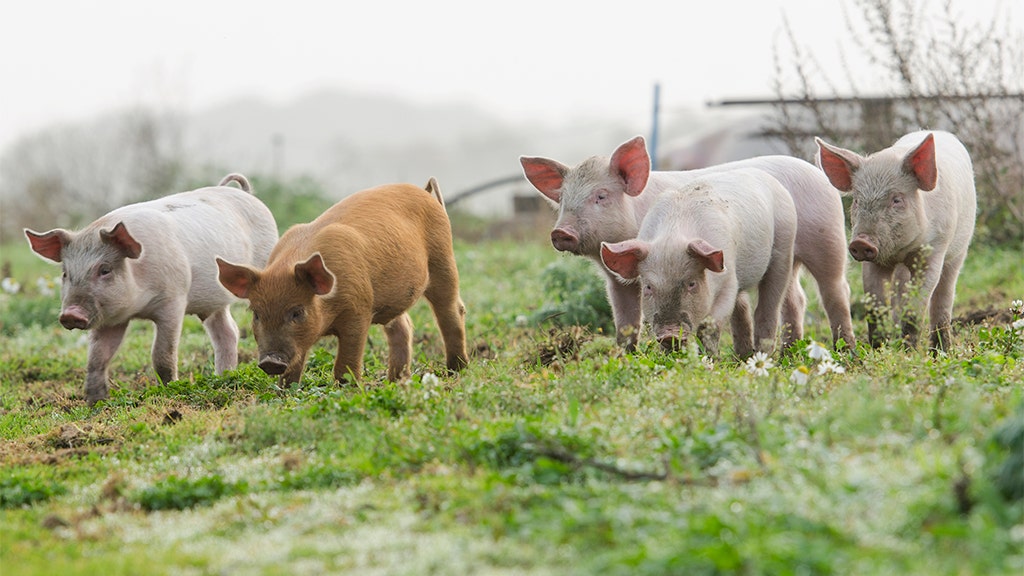
Two piglets recently born in China look like average swine on the outside, but on the inside, they are (a very small) part monkey.
A team of researchers generated the pig-primate creatures by injecting monkey stem cells into fertilized pig embryos and then implanting them into surrogate sows, according to a piece by New Scientist. Two of the resulting piglets developed into interspecies animals known as chimeras, meaning that they contained DNA from two distinct individuals — in this case, a pig and a monkey.
"This is the first report of full-term pig-monkey chimeras," co-author Tang Hai, a researcher at the State Key Laboratory of Stem Cell and Reproductive Biology in Beijing, told New Scientist. Eventually, Hai and his colleagues aim to grow human organs in animals for use in transplant procedures. For now, the team plans to stick with monkey cells, as developing human-animal chimeras presents a slew of "ethical issues," the authors noted in a report published Nov. 28 in the journal Protein & Cell.
To create pig-primate chimeras, Hai and his co-authors first grew cells from cynomolgus monkeys (Macaca fascicularis) in lab dishes. The team then altered the cells' DNA by inserting instructions to build a fluorescent protein, which caused the cells to glow a bright green. These luminescent cells gave rise to equally radiant embryonic stem cells, which the researchers then injected into prepared pig embryos. These glowing spots allowed the researchers to track the monkey cells as the embryos grew into piglets.
Related: The 9 Most Interesting Transplants
In total, 4,000 embryos received an injection of monkey cells and were implanted in surrogate sows. The pigs bore 10 piglets as a result of the procedure, but only two of the offspring grew both pig and monkey cells. By scanning for spots of fluorescent green, the team found monkey cells scattered throughout multiple organs, including the heart, liver, spleen, lungs and skin.
In each organ, between one in 1,000 and one in 10,000 cells turned out to be a monkey cells — in other words, the interspecies chimeras were more than 99% pig.
Although low, the ratio of monkey to pig cells still outnumbered the maximum amount of human cells ever grown in a human-animal chimera. In 2017, scientists created human-pig chimeras that grew only one human cell for every 100,000 pig cells. The interspecies embryos were only allowed to develop for a month for ethical reasons, including the concern that humans cells might grow in the chimera's brain and grant the animal human-like consciousness, according to New Scientist.
Despite these ethical qualms, the same team of researchers went on to create human-monkey chimeras earlier this year, according to a July report from the Spanish newspaper El País. The results of the controversial experiment have not yet been reported, but the scientists said that no human-primate embryos were allowed to develop for more than a few weeks, the paper reported.
Hai and his co-authors may have avoided the ethical issues involved with human-animal chimeras, but one expert wasn't impressed with their interspecies piglets. Stem-cell biologist Paul Knoepfler of the University of California, Davis, told New Scientist that the low ratio of monkey to pig cells seems "fairly discouraging." Additionally, the two chimeras and all eight other piglets died shortly after being born, he noted.
The exact reason for the piglets' death remains "unclear," Hai told New Scientist, but he said that he suspects the deaths are linked to the in vitro fertilization (IVF) procedure rather than the injection of monkey DNA. Other scientists have also found that IVF doesn't consistently work in pigs, according to a 2019 report in the journal Theriogenology.
In the immediate future, Hai and his colleagues aim to increase the proportion of monkey cells to pig cells in future chimeras, and eventually, grow entire monkey organs in their pigs, Hai told New Scientist. In their paper, the authors noted that their work in pigs could help "pave the way" toward the "ultimate goal of human organ reconstruction in a large animal."
Originally published on Live Science.
Science - Latest - Google News
December 11, 2019 at 05:02PM
https://ift.tt/2t9klLF
First pig-monkey chimeras were just created in China - Fox News
Science - Latest - Google News
https://ift.tt/2Kb7H4e
Shoes Man Tutorial
Pos News Update
Meme Update
Korean Entertainment News
Japan News Update
Bagikan Berita Ini














0 Response to "First pig-monkey chimeras were just created in China - Fox News"
Post a Comment